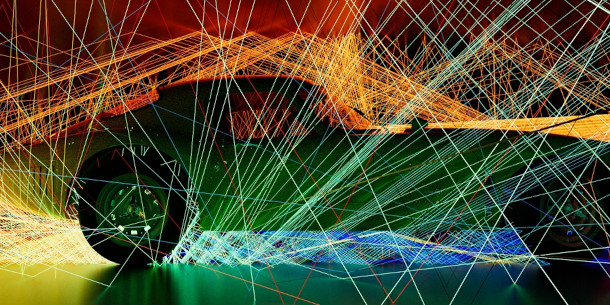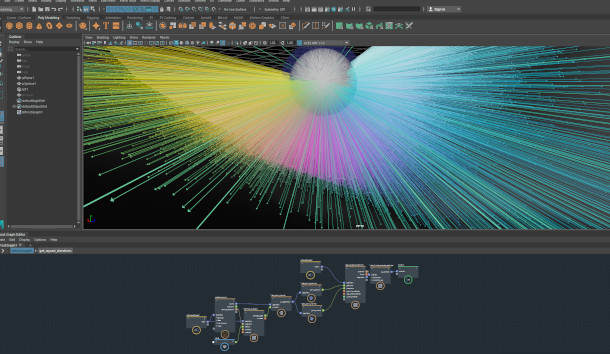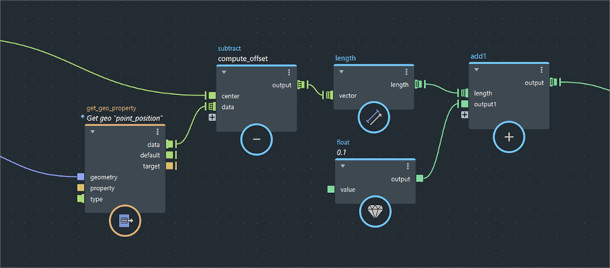Autodesk ships Bifrost for Maya 2.1

Autodesk has released Bifrost for Maya 2.1, the latest version of the Maya multiphysics plugin.
The update – the largest since the plugin was originally released last year – adds new scene geometry queries and better Alembic support, and improves workflow in Bifrost’s node graphs.
Many of the changes are compatibility-breaking, with scenes created in earlier versions of the plugin requiring manual updates before they are compatible with the new functionality.
A powerful node-based simulation environment with a range of physics solvers
First released last year alongside Maya 2019.2, Bifrost for Maya provides a node-based visual programming enviroment in which to author multiphysics simulations.
The plugin, an expanded version of Maya’s original Bifrost Fluids simulation toolset, includes solvers for combustion and granular materials as well as liquids, and is available free with Maya.

New in Bifrost for Maya 2.1: new geometry query types
Today’s update is the largest since Bifrost for Maya 2.0, the version originally released with Maya 2019.2: while Autodesk has put out updates steadily since then, they have mainly been bugfix releases.
New functionality includes four new geometry query nodes, enabling users to identify the closest points on surrounding geometry or the ray cast locations for a given point in a scene, and to sample data from them.
According to Autodesk, this opens up new simulation workflows, making it possible for “a range of new compounds to easily be created, including collision deformers and attribute transfer”.
The queries can be visualised in the viewport with arrows, as shown in the image above.
However, the changes break backwards-compatibility, meaning that graphs created using the geometry query nodes available in earlier versions of the plugin will need to be reconstructed manually.
More streamlined scene graphs, and new node properties
Under the hood, the basic_aero_graph and basic_particles_graph have been streamlined, now including only the mimimum nodes and properties required to run a smoke or particle simulation.
Custom properties can be added via “new menus and shortcuts”, both in the graphs themselves and the source_mpm_sand, source_mpm_snow and source_mpm_fluid nodes, used for particulate and liquid sims.
According to Autodesk, the changes result in “up to ten times speed improvements with graphs that make heavy use of indexing into arrays inside loops”.
There are also quite a few new utility nodes and new properties for existing nodes: you can find a complete list via the links at the foot of the story.
Again, the changes are compatibility-breaking, meaning that the nodes and graphs affected will need updating to their new versions before legacy scenes can be used with version 2.1 of the plugin.

Improved workflow in Bifrost graphs and in the FCurve Editor
Workflow improvements include changes to the UI for the FCurve Editor, including a new thumbnail curve display. The editor also now supports pre- and post-extrapolation functions.
In addition, the interface for Bifrost graphs has been updated, with a new icon to identify auto-looped ports on nodes, and value nodes now displaying the number they represent on screen.
Users can also resolve the type of overloaded ports on referenced nodes by right-clicking and selecting from a list of options, rather than having to create an explicit value node.
Better Alembic support, plus the option to render simulations over 4GB in Arnold
Pipeline integration improvements include improved Alembic support, making it possible to export animation as a single file, rather than generating a separate file per frame of a simulation cache.
Imported and exported Alembic files can also now contain multiple meshes with UVs and point properties; multiple strands with per-strand and per-point properties; and multiple points, with per-point properties.
It is also now possible to render Bifrost simulations over 4GB in size using Autodesk’s Arnold renderer: functionality added in version 4.0.3 of the Maya to Arnold (MtoA) plugin earlier this year.
Pricing and availability
Bifrost for Maya 2.1 is available for Maya 2018+ and MtoA 3.2.2+ running on Windows, Linux and macOS.
Maya itself is available for Windows 7/10, RHEL/CentOS 7.3-7.7 Linux and macOS 10.13+ on a rental-only basis. Subscriptions cost $205/month or $1,620/year.
Read an overview of the new features in Bifrost for Maya 2.1 on Autodesk’s blog
Read a full list of new features in Bifrost for Maya 2.1 in the online release notes
